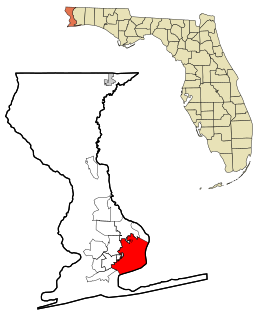
Pensacola is the westernmost city in the Florida Panhandle, and the county seat and only incorporated city of Escambia County, Florida, United States. As of the 2020 United States census, the population was 54,312. Pensacola is the principal city of the Pensacola Metropolitan Area, which had an estimated 502,629 residents as of 2019.
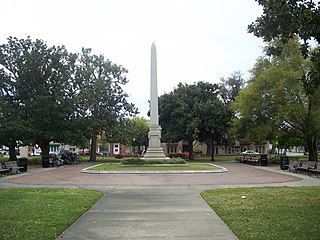
The Plaza Ferdinand VII is an outdoor garden and park in the Historic Pensacola Village area of downtown Pensacola, Florida. It is located on Palafox Street between Government and Zaragoza Streets. It was named after Ferdinand VII of Spain, the King of Spain between 1813 and 1833. A National Historic Landmark, it is the site of the formal transfer of Florida to United States jurisdiction in 1821.

Nicholas Joseph Clayton was a prominent Victorian era architect in Galveston, Texas. Clayton constructed many grand religious and public buildings in Galveston including the First Presbyterian Church. He is also credited as the architect of Sacred Heart Catholic Church and of the Main Building of St. Edward's University in Austin, Texas. He also designed an addition to St. Mary Cathedral in Galveston.
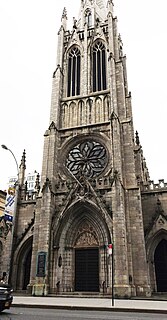
Grace Church is a historic parish church in Manhattan, New York City which is part of the Episcopal Diocese of New York. The church is located at 800–804 Broadway, at the corner of East 10th Street, where Broadway bends to the south-southeast, bringing it in alignment with the avenues in Manhattan's grid. Grace Church School and the church houses—which are now used by the school—are located to the east at 86–98 Fourth Avenue between East 10th and 12th Streets.

The Seminole Heights Residential District, known also as the Seminole Heights Historic District, is a U.S. and Local Historic District located in Tampa, Florida. The district is roughly bounded by Hanna Avenue to the north, Cherokee Avenue and I-275 to the east, Florida Avenue to the west, and Osborne Avenue to the south.
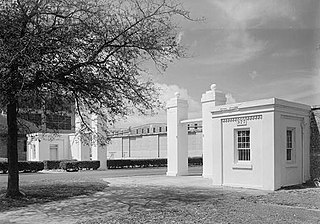
The Pensacola Naval Air Station Historic District encompasses the early historic elements of Naval Air Station Pensacola in Warrington, Florida. Included in the historic district are surviving buildings of the Pensacola Navy Yard, which the air station took over, as well as buildings related to the early years of aviator training by the United States Navy. The district, roughly bounded by West Street, Saufley Avenue, and Pensacola Bay, was designated a U.S. National Historic Landmark District in 1976.

The 1867 Matheson House is a historic building in Gainesville, Florida, United States. It is located at 528 Southeast 1st Avenue. It was the home of James Douglas Matheson and Augusta Florida Steele Matheson, the daughter of Florida pioneer Augustus Steele, who founded Hillsborough County and Cedar Key. James Douglas Matheson owned a dry goods store in downtown Gainesville and was active in local and state politics, as was his son, eight-term Gainesville mayor Chris Matheson, who was also a state legislator.

The Saenger Theatre, also known as the Saenger Theater, is a historic theater in Pensacola, Florida. It is located at 118 South Palafox Place. On July 19, 1976, it was added to the U.S. National Register of Historic Places.

For the similarly named building in West Tampa see El Centro Español of West Tampa

The Clara Barkley Dorr House is an historic home in Pensacola, Florida. Built in 1871, it is located at 311 South Adams Street. On July 24, 1974, it was added to the U.S. National Register of Historic Places for its classical revival architecture.

The St. Michael's Creole Benevolent Association Hall is a historic site in Pensacola, Florida. It is located at 416 East Government Street. On May 3, 1974, it was added to the U.S. National Register of Historic Places.

The Thiesen Building, built in 1901, is a historic site in Pensacola, Florida. It is located at 40 South Palafox Street. On December 13, 1979, it was added to the U.S. National Register of Historic Places.

St. Joseph Catholic Church is a historic Black Catholic parish in Pensacola, Florida. On July 10, 1979, it was added to the U.S. National Register of Historic Places.

The Maitland Art Center is a historic site in Maitland, Florida. It was founded and designed by architect and artist J. Andre Smith (1880-1959) in 1937 as an artist colony, dedicated to experimental art. Funded by philanthropist Mary Curtis Bok, the colony hosted artists such as Ralston Crawford, Milton Avery, and Consuelo Kanaga. It is located at 231 West Packwood Avenue. On November 17, 1982, it was added to the U.S. National Register of Historic Places.

The former St. Andrew's Episcopal Church building, also known as Old St. Andrew's Event Venue, is an historic building located at 317 Florida Avenue in downtown Jacksonville, Florida. It was originally an Episcopal church, but closed when the parish relocated to the suburbs in 1960. On May 4, 1976, the edifice was added to the U.S. National Register of Historic Places. In the 1990s it was purchased by the City of Jacksonville and turned over to the Jacksonville Historical Society (JHS), and now serves as an event venue managed by the society.
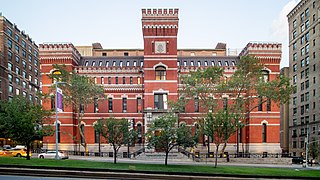
The Seventh Regiment Armory, also known as Park Avenue Armory, is a historic National Guard armory building located at 643 Park Avenue in the Upper East Side neighborhood of Manhattan, New York City. The building is a brick and stone structure built in 1880 and designed in the Gothic Revival style by Charles Clinton.

The Cathedral of the Sacred Heart, is the seat of the Bishop of the Roman Catholic Diocese of Pensacola-Tallahassee. It shares this distinction with the Co-Cathedral of Saint Thomas More in Tallahassee. The cathedral is named in honor of the Sacred Heart of Jesus, and is located in Pensacola, Florida.
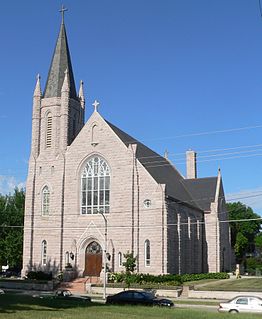
Sacred Heart Catholic Church is located at 2206 Binney Street in the Kountze Place neighborhood of North Omaha, Nebraska within the Roman Catholic Archdiocese of Omaha.
Frederick H. Trimble was an American architect in Central Florida from the early 1900s through the 1920s. He worked in the Colonial Revival, Spanish Colonial Revival and Prairie Style.

Wilbur B. Talley was an architect in Florida. He worked in Jacksonville until the death of his wife Nellie and daughter Sarah, who were riding in a car hit by a train on December 21, 1919. After the accident, he moved to Lakeland, Florida where he continued working as an architect.
























